The Japan Italy Bridge column continues to promote in-depth studies related to the world of Japan, today we are talking about Okinawa and the case of the over one hundred-year-old population.
“At 70 you are only a child. At 80 you are a young man. At 90, if your ancestors call you to heaven, ask them to wait until you are 100 years old. Then you can think about it”. So says an ancient saying in Okinawa, unfailingly quoted every time you get ready to talk about its mythical inhabitants. Words that seem to find confirmation, even in ancient legends that would speak of this place as a “Land of the immortals”.
Okinawa 沖縄 The case of the over centenarians
Guest Author: Flavia
A few years ago even the show “Le Iene” brought the case of Okinawa to prime time, giving us a very nice report. The longevity of its inhabitants and even more so the incredible quality of their ageing is immediately witnessed by the first two ladies who appear in the tv show. I think that whoever saw them was amazed: I don’t lie if I say that they show something like 15 years less! Unbelievable. As noted by the journalist Nadia Toffa, sent by the tv show in question, we also have them here in Italy. So the point is, how do you get to those ages. That is: with what quality of life? Usually, the pains of our elderly people, as we know, are such as to affect the quality of their last journey of life. As a society, it is now accepted that illness and loss of autonomy are what is hopelessly awaiting us when we cross those age thresholds. Well, the case of Okinawa’s (super-) grandparents shows us that things don’t have to be like that! And that it is in everyone’s power to ensure psycho-physical well-being during, starting from … as soon as possible! The sooner you start to treat yourself, the better you can prepare for your old age.
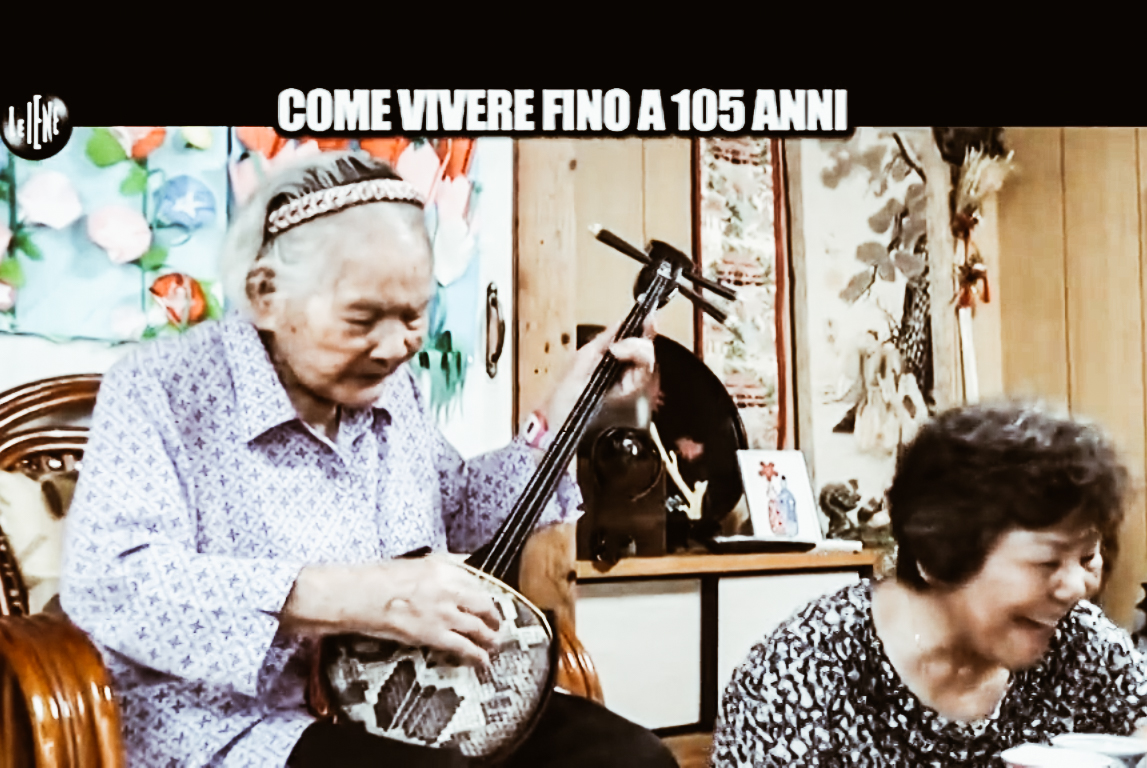
photo credits: mediaset.it
The typical ailments of our western societies – which often even young people(!) like to experience – Okinawa’s elders almost don’t know what they are. The incidence of diseases related to senility or degenerative diseases such as osteoporosis, Alzheimer’s disease, sclerosis, cancer… is very low.
Okinawa: blue zone, paradise of longevity
These people have an extraordinary quality of life own on this island. We are talking about people who have never been to the hospital, who have never taken medication… who are even able to continue working or driving their car beyond the age of 90/95. Who in any case have a margin of autonomy unthinkable for a local elderly person, except in sporadic cases. Among them, the small village of Ōgimi stands out for the high concentration of centenarians compared to the total number of inhabitants. In reality, a case of similar longevity is present, you will know, also in our house: in the nearby Sardinia. Not by chance: Okinawa, Sardinia, the Greek island Ikaria, the Costa Rican Nicoya and a small community near Loma Linda in California, all fall under the name of “blue zone”.
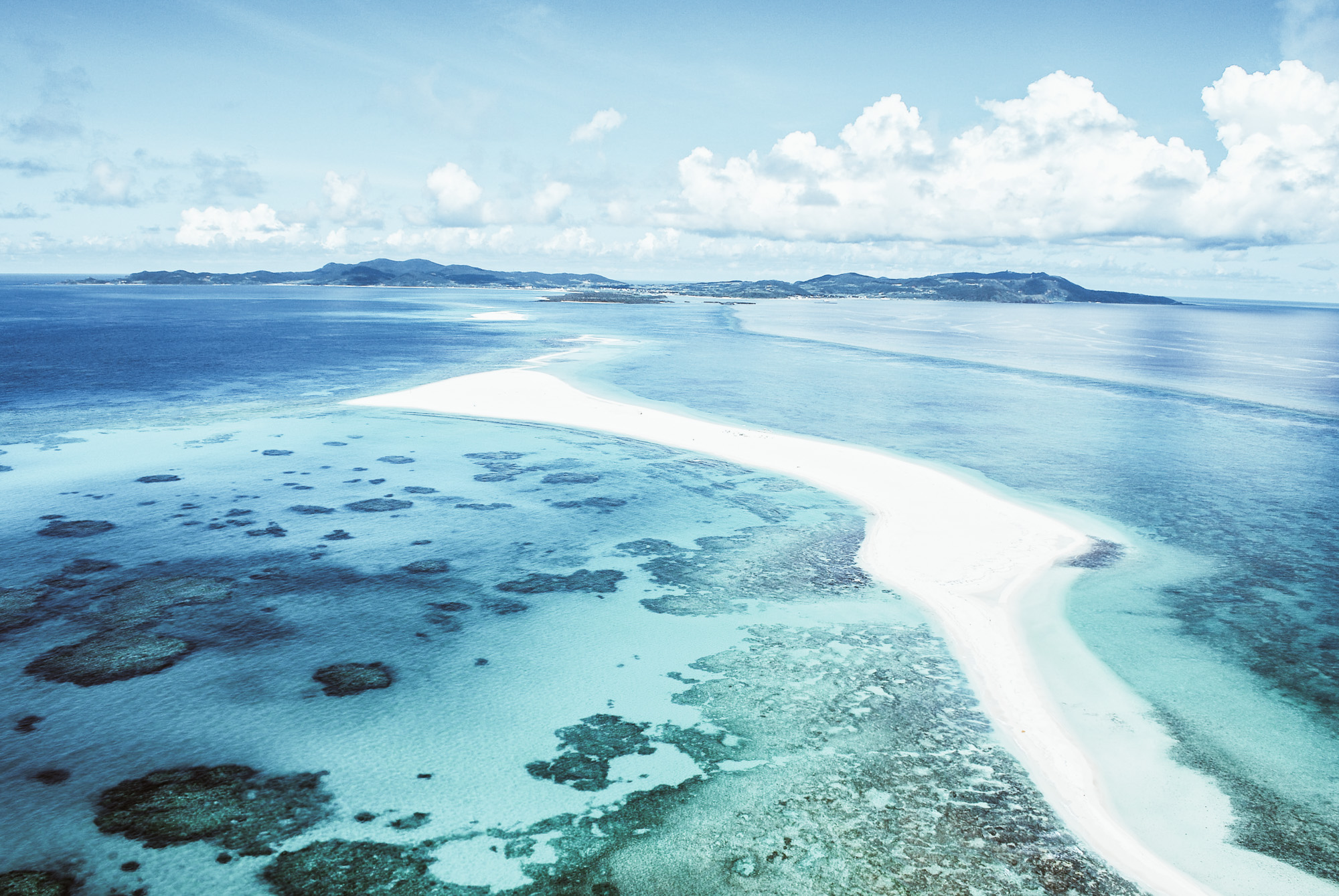
photo credits: ilviaggio.biz
Any area in the world where life expectancy is higher than the general average is called the “Blue Zone”. Real “paradises of longevity” that attract researchers from all over the world to try to capture the “secret” of their populations. In this sense, Okinawa and its inhabitants even surpass even mainland Japan, which does not lag behind in terms of quality of life, but has a higher incidence of disease, for example.
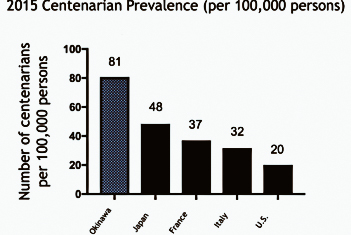 photo credits: orcls.org
photo credits: orcls.org
But who are the Okinawans? Let’s first find out who we’re dealing with.
Identikit of the Japanese “tropics”
Okinawa is the main complex ( 沖縄諸島 Okinawa-Shotō ) of the Ryūkyū archipelago and is located between “mainland” Japan and Taiwan. It consists of a main island of the same name plus other smaller islands. Naha ( 那覇 ), is its capital. It was named prefecture of Japan in 1879 although the Ryūkyū complex ( 琉球諸島 Ryūkyū -Shotō ), which incorporated it, was formally annexed in 1874. At that time Japan was in the process of modernization and this was matched by a process of unification of all the territories of the archipelago under a single flag.

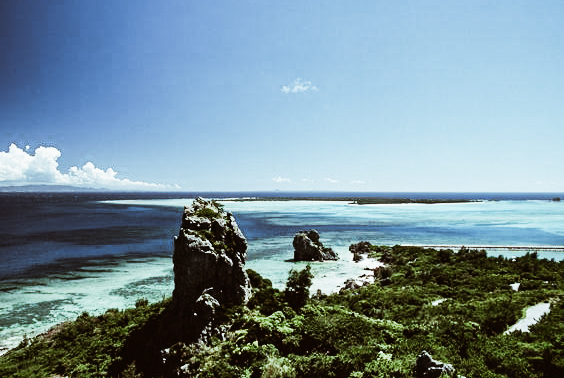
photo credits: lacooltura.com, pinterest.it.
Before 1874 Ryūkyū was an autonomous kingdom, whose foundation in the 15th century led to the unification of the islands of Okinawa. Formally it was recognized by the Tokugawa – lords of Japan until 1868 – under the jurisdiction of the fief of Satsuma (today Kagoshima Prefecture). In fact, however, it was independent, so much so that it was the fiscal kingdom of both Japan Tokugawa and, even before that, China.
Okinawa is a rather peculiar region, more in its own right than the rest of Japan. It is influenced by China and South-East Asia, due to the frequent trade and cultural exchanges maintained by the Ryūkyan Kingdom over the centuries. Okinawa cuisine itself and Karate, the made-in-Okinawa martial art par excellence, are the result of such interactions.
The lush nature of these islands, made up of numerous coral reefs and extensive rainforests, together with a sub-tropical climate, makes Okinawa a true paradise. It is not uncommon to find it referred to under expressions such as “tropical corner” or “Caribbean” of Japan. A climate that is somewhat reminiscent of that of the blue zones of Sardinia and Ikaria, which are also islands. I am not surprised that paradises like these can host “elixirs” of long life.
But let’s see what researchers’ discoveries tell us about Okinawa’s elixir.
The ORCLS researchers’ studies
The Okinawa Centenarian Study (OCS), is the longest centenarian study currently in existence. It is conducted by the Okinawa Research Center for Longevity Science (ORCLS) research team, which has been reviewing various aspects of local life since 1975. Among these, social, psychological and spiritual aspects are also given high consideration. Professor Craig Willcox, interviewed in the service by the Hyenas, is one of the leading researchers. Willcox tells the Hyenas’ cameras about the discoveries his team has made over the years. First of all, the presence of a particular gene, FOXO3, readily christened the “longevity gene”, was observed. However, the researchers found that longevity and longevity quality are inversely proportional to a number of health risk factors that were present before the age of 50. That is, the chances of reaching at least 85 years of age in good health increase if there are no more than 7 risk factors before middle age. Conversely, with more than 7 factors, Willcox tells us that the odds can be as high as 0%.
And here are the risk factors:
- Hyperglycemia (with risk of diabetes)
- Hypertension (with risk of heart attack or stroke)
- Excessive alcohol consumption
- Low level of education (education would foster a greater awareness of what it means to have a healthy lifestyle)
- Being overweight
- Poor diet (lack of vitamins, proteins, mineral salts)
- High triglycerides (with risk, for example, of arteriosclerosis)
- Low gripping force in the hands
- Smoking
- Only for men: don’t be married!
The latter is quite curious, as Toffa immediately notes in his interview. Willcox motivates him as follows: “women are much better [at taking care of themselves] they don’t need men, they can survive without them”. This is why having a woman at your side would increase the life expectancy of the average man. However things may be, if we think that historically Okinawa women play a key role in Okinawa society, this could take on a wider meaning. And good Okinawan women!
Not only Okinawa DNA
But the research does not end there. Willcox says he and his team examined a sample of 8000 men with Japanese ancestors in their genealogy. Considering the two analysis variables, presence of the FOXO3 gene (1) and healthy lifestyle (2), they divided the subjects into 4 groups. Well: the individuals who possess the gene linked to longevity, however, have an incorrect diet, live less than those who, although not genetically predisposed, maintain a healthy diet. This clearly shows us – as Willcox says – the power that a healthy diet and lifestyle have on the physical health of individuals.

photo credits: mediaset.it
Another thing observed is that the Okinawan population does not consume more than 1100 calories per day. This is 10% less than the calories usually indicated by each nutritional table. In particular, their habit of “nibbling rather than bingeing,” Willcox always explains, “is key. But a snack made from healthy food: snacks, for example, are made from dried fruit or dried fish (a snack that is also common in mainland Japan). All this in conjunction with a broader, healthier lifestyle.
Shall we find out in detail what all this consists of? Let’s start with eating habits.
#1 Traditional diet
Two, are basically the principles underlying the Okinawan diet and concern quantity and quality of food.
腹八分 (Hara-Hachi-Bu): ” stomach [full] for 8 parts”
That’s 8 parts out of 10: “Always leave some space in your stomach…that is, eat until you are 70-80% full” explains Willcox. A guideline, it would seem, of Confucian origin, which seeks moderation rather than satiety: never fill up completely but eat what is strictly necessary. And in fact, the second elder tells journalist Toffa: “I eat what is right but never fill myself completely. I always get up with a bit of hunger”.
The Okinawans are used to eat 5 meals a day (which is also recommended by local doctors), opting for low-calorie but satiating foods. Let’s keep in mind the setting of the table, which is typical of Japanese cuisine. The contemporaneity of the dishes, through their arrangement in saucers and bowls, is a factor that certainly predisposes more to “small tastings” than to binge.

photo credits: travelbook.co.jp
I-Shoku-Dō-Gen ( 医食同源 ), “food and medicine, same origin”, from Okinawa
For the local elderly, there is nothing healthier than lovingly caring for the garden and then feeding on the fruits of the earth. If we add marine food to these, we have our own miracle diet. This is what it is made up of:
- Greens. Especially with green leaves, yellow roots and orange roots, all containing carotenoids and anti-inflammatory agents.
- Tubers like the sweet purple potato of Chinese origin, with a very low glycemic index. Eugenio Iorio, an Italian researcher, explains: “it is there [in the purple] that these famous polyphenols […] dialogue with our DNA and therefore help us to control the effect of free radicals”;
- Legumes. Like soya beans (with protein and fibre but without fat) and soya derivatives;
- Algae, natural anti-inflammatory, ideal for free radicals and also for hair;
- Fish and the already mentioned dried fish, rich in magnesium and omega 3;
- Tea. Especially green tea and jasmine tea, anti-ageing;
- Herbs to chew like Sakuna, “herb-elixir” slimming and antioxidant;
- Fruits. Among which bitter melon Goya, used in the typical dish “Goya Champuru” and citrus Shikuwasa, anti-inflammatory, both typical of the place.
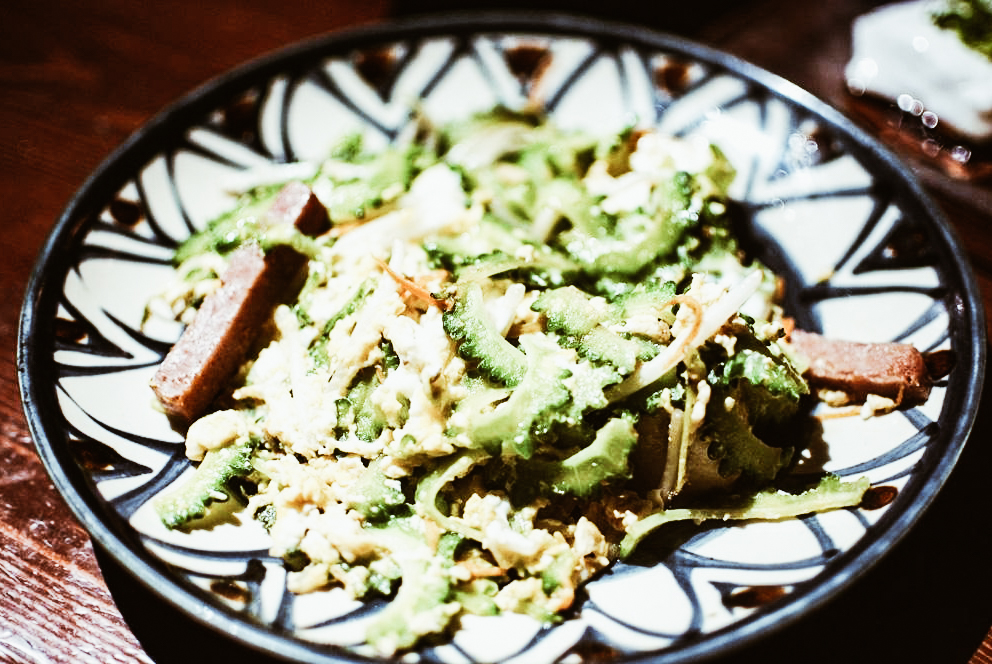

photo credits: ohayo.it
“Eating like a rainbow”
In the words of Dr Willcox, by virtue of the parade of colours that the great variety of fruit and vegetables brings to the tables of Okinawa. Variety. Another watchword in the agenda of the Okinawans who would use at least 18 foods daily. The important thing, however, is always to respect the seasonality of the fruit and vegetables. In this way, the maximum nutritional potential of the fruit and vegetables can be realised. And of course, the freshness of the food. It is also important if you decide to cook them, especially when it comes to fish and vegetables: never overcook them if you want to preserve the nutrients!
In addition to very low consumption of carbohydrates, salt and sugar are also used very little. Yes to spices, such as turmeric, and mushrooms.
What about meat?
As a result of that Chinese influence mentioned at the beginning, meat consumption is also well established in Okinawa’s cuisine. But meat, as well as dairy products and cereals, are categories with a high nutritional density…so they are consumed in even smaller quantities! Even rice is eaten less than the rest of Japan and quinoa is often preferred to rice. We speak of a low-calorie diet also for this reason; because it counterbalances with smaller quantities of nutritional contributions otherwise potentially excessive. Also because vegetable and marine foods and fruit remain the true carriers of all those beneficial substances that make up the food elixir of Okinawa.
#2 Motor and mental activity
“When the body moves, the brain goes into rhythm” – this is the motto of Jim Kwik, an internationally renowned trainer who deals with fast learning. Kwik always urges even those who have to spend their days sitting down for work or study not to stay in the chair all the time but to take breaks and move around. Even just a few minutes of simple movements between breaks, as well as drinking water and making small snacks, are enough. In doing so, Kwik suggests, our performance is even better, because the brain works better if we treat ourselves this way. Exercise as a stimulator of neurogenesis and neuroplasticity: facilitates the creation of new neural connections. In short, physical movement is also a gym for the brain! That comes out strengthened. And if the brain is active the whole organism benefits. It is a vicious, beneficial circle that, when activated, becomes self-feeding. And this is also the basis for all the nutritional discourse that has just been made, as well as the other factors that we will see in a moment. Let us bear in mind that this discourse is not compartmentalised: everything is connected.
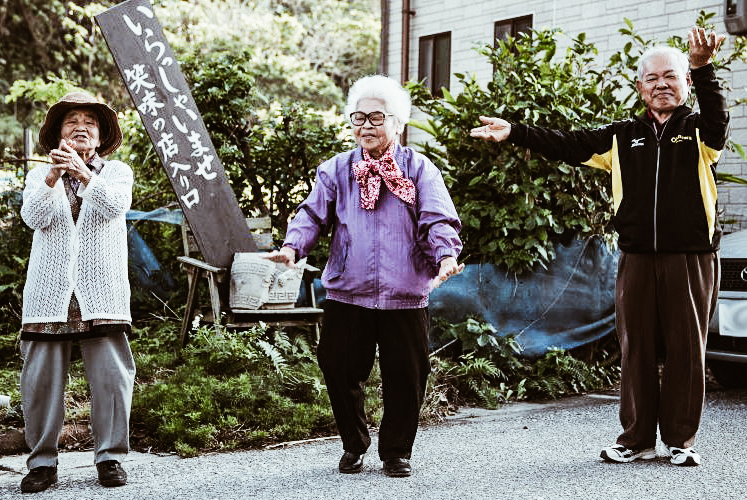
photo credits: okinawa.stripes.com
Observing the lives of our Okinawans, we find that, in their own way, they put into practice very similar things to those promoted by Mr. Kwik. The second reason for their well-being lies in the fact that they are active, not only in their body but also in their mind! The grandfather we see in the hyena service, for example, reads the newspaper every day when he returns from his morning walk. And watch out, 100 years go by, he does so without the help of glasses. Not to mention the fact that he worked in the countryside until he was 97 years old!
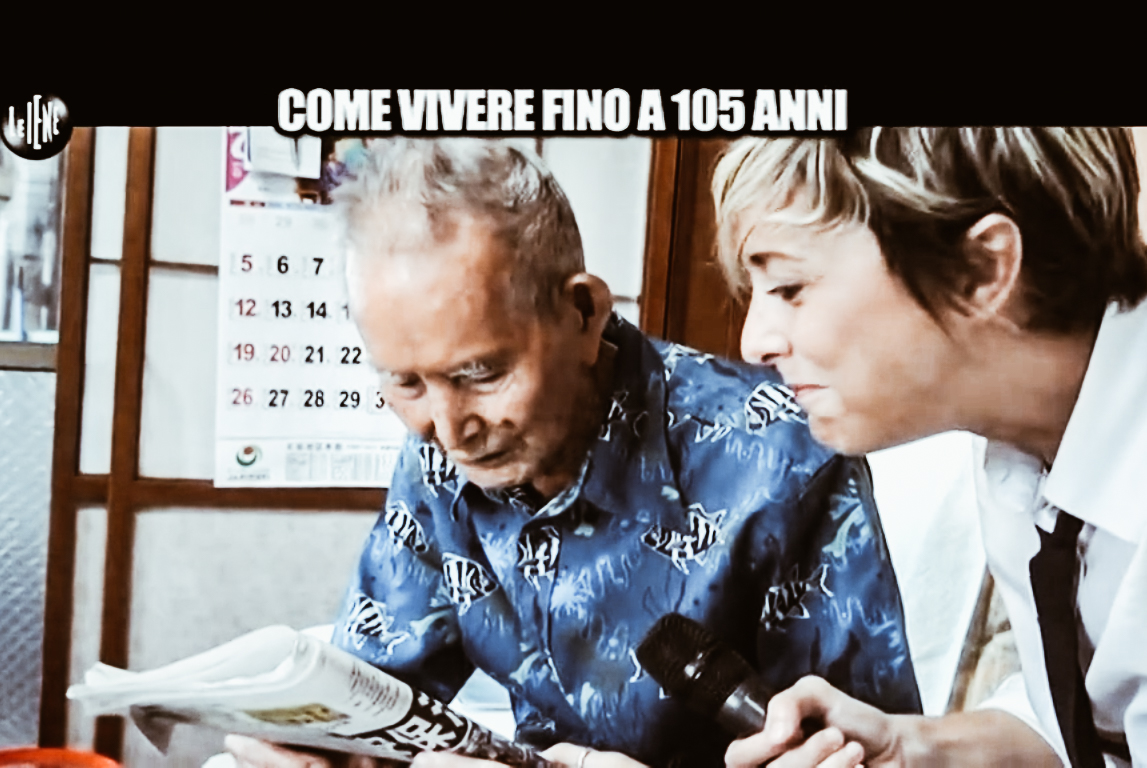
photo credits: mediaset.it
Among the activities most loved by Okinawa’s grandparents – in addition to the garden, as already mentioned – we find traditional dance or dabbling with some traditional musical instrument. Or, martial arts, ideal for the body-mind-spirit system, as in the case of master Seikichi Uehara. Uehara, a few years before his death at the age of 100, still taught Karate to his students. Or again: how not to mention the weaver Toshiko Taira who, at the age of 100, continues to work as a weaver of Bashōfu, an ancient fabric used for the Kimono (produced only at Ōgimi).
#3 Interior and exterior attitude
But it’s not just a question of genes and nutrition. Turn that turns you back, you always come back there: the mind (and the spirit, which in the Japanese vision is one with the mind – as the parola心 “Kokoro” or heart/mind) testifies. Once again, the vision of things proves to be decisive. The most cynical ones will be tired of always hearing “the same old tune”, I know; but instead of automatically throwing it on scepticism, I would start to give more credit to the “power of the mind”. There will be a reason for this if it is invoked from many quarters. Those who have somehow experienced the beneficial influences of a clean mindset, from excessively… interpretative distortions of reality, let’s put it this way.
The perception of the world and therefore of oneself has the power to affect the tangible world of people. Let’s think about psychosomatic illnesses for example…or even just inner dialogue: thoughts or words directed towards something can influence this something, including ourselves.
Thus, even Okinawan scholars recognise optimism as a not inconsiderable factor, as well as more tangible factors. Optimism, attention, understood not as pretending that the challenges in life do not exist…but as a different way of accepting both the good and the bad. An openness towards life, which avoids complaining and the negative vision of things. A serenity given by knowing one’s own soul and place in the world, with a consequent trust in life and in others. From giving the benefit of the possibility, to everything and everyone.
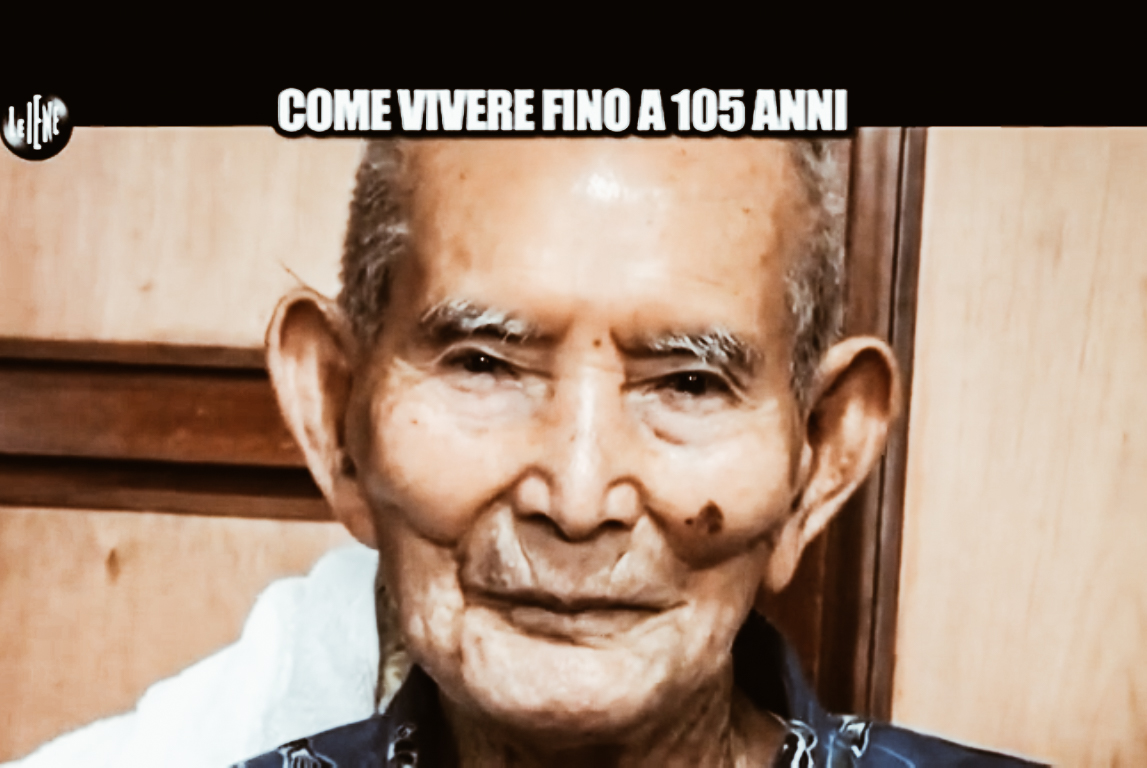
photo credits: mediaset.it
#4 Interpersonal relationships and social life
When this happens, the mind/spirit “machine” works properly and you feel better at 360 degrees. Even in the seemingly obvious little things that have their own importance, such as simple but authentic moments of conviviality. People in Okinawa generally have a very healthy social life, based on trust and balanced communication. It is often overlooked, precisely because it may seem like “the usual rhetoric”, but, believe me, communication is essential to maintain healthy and satisfying human relationships. When people manage to have sincere, spontaneous, and serene communication – without any quarrels of any kind – the relationships are perfectly balanced. Without balanced and satisfying human relationships, the life of a human being is not the same. Just as moments of healthy solitude are essential, to rebalance oneself and recover one’s energies, so, at a certain point, are human relationships. But be careful: they must be healthy and balanced. Just like those of our Okinawans.
The deep sense of belonging to the community that characterises their network of relationships and the value attributed to the elderly creates a buffer effect on the elderly that gives them confidence. With a community ready to support them, grandparents can thus live freely and still feel useful. Would you have me believe that the love and trust surrounding these people do not contribute to their quality of life?
#5 Spirituality
And all this takes us towards the last factor that remains for us to consider: spirituality. It “ferries us” because an approach to life like the one we have seen, from that part of the world, goes hand in hand with a certain kind of spiritual sensitivity. These two things are intimately linked if we think about it, and it could not be otherwise.
The philosophy of finding one’s own reason to live, what gives it meaning, is from Okinawa, the famous Ikigai ( 生き甲斐 ). If this is missing, there is no healthy diet or strong genes to keep, for a long and quality life. Even the saying “Nan kuru nai sa ( なんくるないさ )” that is “Don’t worry [it’s all right] ” is made in Okinawa. It indicates the profound belief that everything that happens in life has its own intrinsic meaning and that it serves us, for our growth. Having said that, everyone can and should do everything in his or her power in the situations that life confronts him or her with. If this is done, then the motto says to us “you have nothing to fear: everything you could do you have done, so it is all right, be at peace. Everything is as it should be”.
Prayer and meditation, also beneficial against stress, are very present in the life of the Okinawans. In the morning, for example, they gather in front of an altar traditionally present in their homes to commemorate and thank their ancestors. This aspect of thanksgiving is something very important that potentially has an impact on the mentality and one’s own worldview. And the same care of the vegetable garden already invoked higher up or even eating calmly (devoting all the attention to the act itself, without dispersing it with the TV, for example), is in truth in itself, already meditation.
Nature and environment
A spirituality in any case always close to nature…that recognizes the soul. Could it be that it is precisely the sharing with nature that has inspired these people over time to the right behaviour for a beneficial lifestyle? Although this specific aspect is difficult to quantify with empirical data, I believe so. Also because, if we take for granted that mentality and worldview can have power over our lives… why then discard a priori the power of the “spirit of nature”? Just like animals (think of pet-therapy), so can nature.
The spiritual is very present all over Japan but in Okinawa, it can count on a more uncontaminated nature, at least, compared to other places in the world. Let’s remember that the increase in free radicals – potentially responsible for cancer – is also favoured by pollution as well as by bad behaviour. In order to link up with what we said at the beginning when we were thinking about the other blue areas, even the environmental factor – the ecosystem – has its own weight.
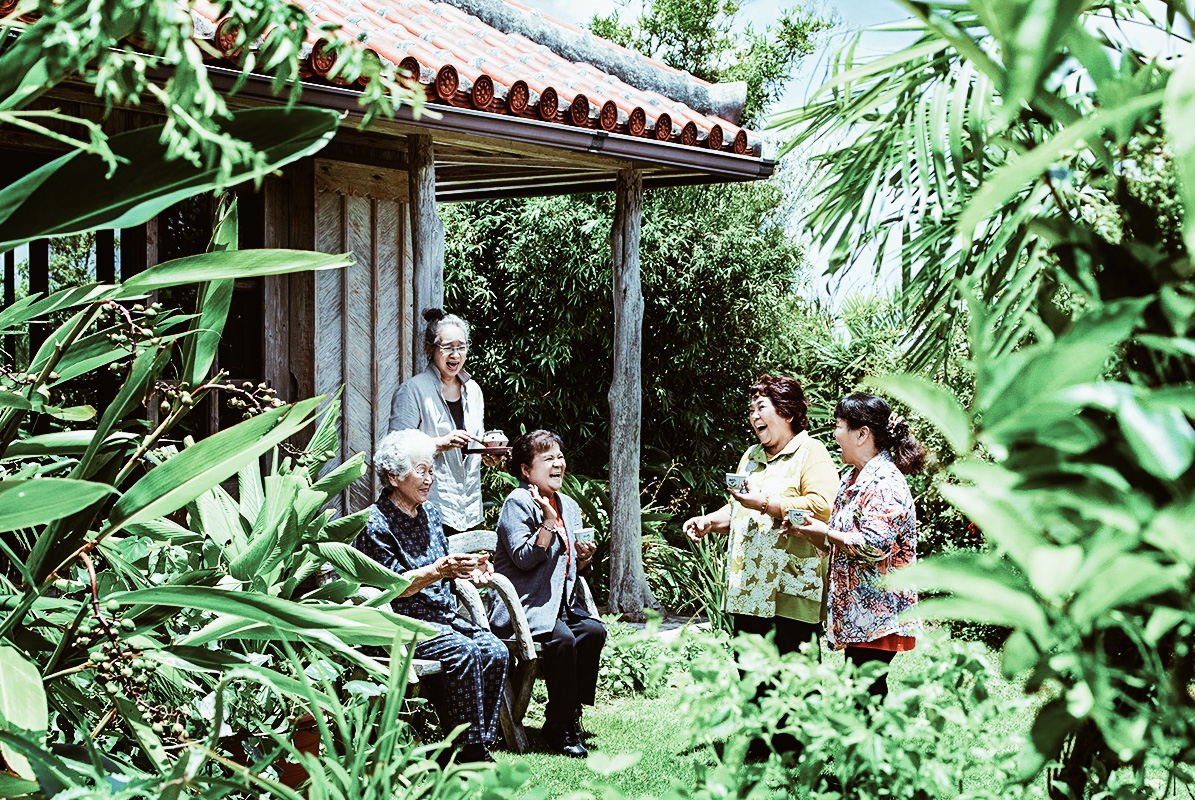
photo credits: visitokinawa.jp
The power of the Okinawa lifestyle
And so, alongside: healthy and balanced nutrition; the balanced activity of body and brain; a good relationship with life and consequently with others, here we have the spiritual dimension. But again, there is no hierarchy between these factors: just like the courses of the Japanese tables, they are all contemporary. Each one depends on the other and each influences the other. Of course, you will say, there is always a genetic predisposition. But while genes are not chosen, all these factors are in the hands of individuals. They are in their power. Good genes are undoubtedly a plus. However, as widely observed in OCS research, an individual with a healthy lifestyle lives better and for a long time, even without such a gene. While its effectiveness can also be cancelled out by the lack of just one of the other factors. This is already being demonstrated by the new generations of Okinawa. In fact, the young people of the area are at risk of losing the health benefits of their grandparents by becoming westernized between sedentariness and technology, consumption of pre-packaged food full of colourings.
Even in Italy, it is possible to have the same nutritional benefits as the Okinawa diet. After all, our Mediterranean diet, as Eugenio Iorio also tells us, is based on the same principles. Therefore, we also have the same food supplies in our lands and in our sea. We also talk about “MediterrAsian diet” if we try to integrate the two nutritional models. On the other hand, the Okinawa lifestyle and the Sardinian and Ikarian styles have some aspects in common: high consumption of vegetables and legumes, active and especially outdoor life, and finally, social life and strong family ties.
Share this:
- Click to share on Facebook (Opens in new window)
- Click to share on Twitter (Opens in new window)
- Click to share on Tumblr (Opens in new window)
- Click to share on Pinterest (Opens in new window)
- Click to share on Telegram (Opens in new window)
- Click to share on WhatsApp (Opens in new window)
- Click to share on Reddit (Opens in new window)
- Click to print (Opens in new window)






